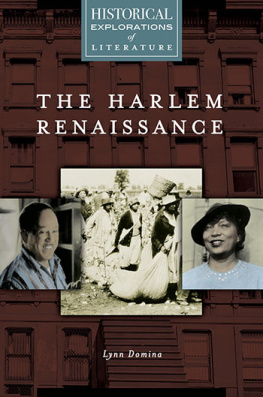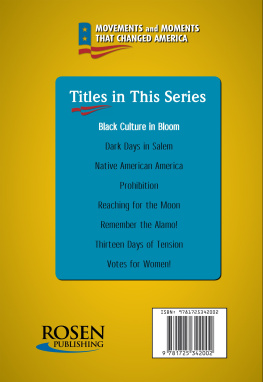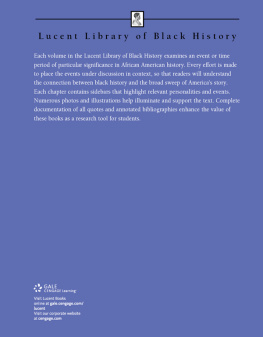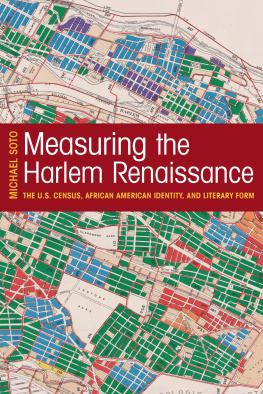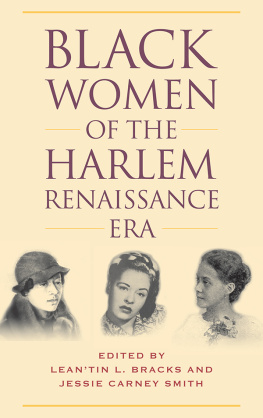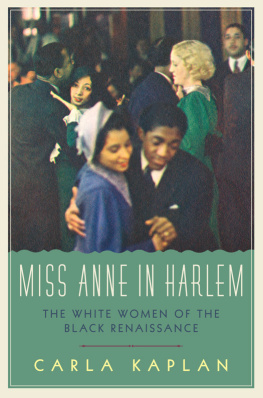THE HARLEM
RENAISSANCE
Recent Titles in Historical Explorations of Literature
American Slavery: A Historical Exploration of Literature
Robert Felgar
THE HARLEM RENAISSANCE
A Historical Exploration of Literature
Lynn Domina
HISTORICAL EXPLORATIONS OF LITERATURE
Copyright 2015 by ABC-CLIO, LLC
All rights reserved. No part of this publication may be reproduced, stored in a retrieval system, or transmitted, in any form or by any means, electronic, mechanical, photocopying, recording, or otherwise, except for the inclusion of brief quotations in a review, without prior permission in writing from the publisher.
Library of Congress Cataloging-in-Publication Data
Domina, Lynn.
The Harlem Renaissance: a historical exploration of literature / Lynn Domina.
pages cm. (Historical Explorations of Literature)
Includes index.
ISBN 978-1-61069-649-4 (hardback: acid-free paper) ISBN 978-1-61069-650-0 (ebook) 1. American literatureAfrican American authorsHistory and criticism. 2. Harlem Renaissance. 3. Literature and societyUnited StatesHistory20th century. 4. African Americans in literature. 5. Harlem (New York, N.Y.) Intellectual life20th century. I. Title.
PS153.N5D596 2015
810.9'896073dc23 2014026323
ISBN: 978-1-61069-649-4
EISBN: 978-1-61069-650-0
19 18 17 16 15 1 2 3 4 5
This book is also available on the World Wide Web as an eBook.
Visit www.abc-clio.com for details.
Greenwood
An Imprint of ABC-CLIO, LLC
ABC-CLIO, LLC
130 Cremona Drive, P.O. Box 1911
Santa Barbara, California 93116-1911
This book is printed on acid-free paper 
Manufactured in the United States of America
Contents
The Harlem Renaissance refers to a period, primarily during the 1920s and 1930s, when African American literature, music, and other arts flourished. Many poets, dramatists, and novelists who would profoundly affect later writers published their most memorable work during this time. Although the energy of this movement was centered in Harlem, a neighborhood on the northern end of Manhattan in New York City, its influence spread throughout the country and then internationally. Most of the writers who became prominent during the Harlem Renaissance lived in New York City for at least a time, although many of them had been born elsewhere, and some produced much of their work while living in other locations. They were generally young, however, having come of age when the 20th century was new, and their expectations mirrored this expectantly new time.
Of course, no movement, literary or otherwise, springs fully formed out of nothing. The conditions that made the Harlem Renaissance possible had begun to form soon after (or even before) the American Civil War. The abolition of slavery was not at all synonymous with racial equality. During the last decades of the 19th century and the first few of the 20th, progressive Americans debated the best strategies to incorporate former slaves and their descendants as full citizens. Two major figures in the generation immediately preceding the Harlem Renaissance were Booker T. Washington (18561915) and W.E.B. Du Bois (18681963). Literary critic Houston Baker argues that a profound change occurred in American thinking generally and African American thinking particularly as a result of Washingtons Atlanta Exposition Address in 1895. The founder of Tuskegee Institute in Alabama, Washington urged African Americans to focus their energies on vocational education, acquiring skills that would permit them to support themselves, demonstrating their responsibility to white southerners who resisted integration and political enfranchisement for African Americans. In contrast, W.E.B. Du Bois argued for more immediate political and civil rights; he used the term talented tenth to refer to African American leaders who would help others achieve this goal. Because Du Bois was not a southerner, his experience of discrimination was different from Washingtons, and he could propose actions that would be more feasible in metropolitan regions of the northeast United States than they would be in the more rural South. Du Bois was one of the founders of the National Association for the Advancement of Colored People (NAACP), and he also participated in Pan-African Congresses that sought to address European colonialism in Africa as well as the situations of people of African descent who lived in Europe and the United States.
As the Harlem Renaissance began, World War I had just ended. Initially, most Americans did not support U.S. entry into the war, and the war raged in Europe for three years before the United States became directly involved. During these years, approximately half a million African Americans migrated from southern states to the North, creating new homes in major cities like New York, Detroit, and Chicago. Economic as well as social conditions affected desires to move north. Most African American farmers in the South did not own their land and had very little opportunity to improve their status. Then the boll weevil decimated cotton crops throughout the South during 1915 and 1916, further impoverishing African American sharecroppers. The comparative freedom these migrants experienced in the North, combined with southern traditions of music and storytelling, influenced much of the literature that writers would create during the 1920s and 1930s and later. When the United States entered the war in 1917 in order to, as President Wilson declared, make the world safe for democracy, many African Americans perceived this goal as hypocritical, given the level of discrimination and segregation that was often enforced by law within the United States. Nevertheless, African Americans responded to the national call for military service by the thousands, even though the military itself remained segregated. After the war, returning soldiers understandably hoped that their patriotic service would result in a warmer reception by their fellow citizens in their own country.
Such was not to be, at least not immediately. World War I ended in November, 1918. The summer of 1919 was plagued with race riots in several cities, especially in Washington, D.C., and Chicago, and the number of lynchings increased through the South. The Ku Klux Klan, originally established immediately after the Civil War, saw a resurgence in membership during the first few decades of the 20th century. In 1925, over 50,000 Klan members participated in a march in the nations capital. It looked as if African Americans would not be able to define their patriotism during the war as a cultural victory, but their military experience and sacrifice did galvanize many people to assert their rights with much more energy.
The fear of social disruption in the United States following the war was significantly influenced by the Communist Revolution in Russia that had occurred in 1917. Although the most dramatic panic over Communism in the United States would not occur until the McCarthy era during the 1950s, these fears were planted decades earlier. Simultaneously, many Americans, including some of the writers affiliated with the Harlem Renaissance, were genuinely interested in communism and explored its application to American problems of poverty and racism. Langston Hughes and Claude McKay, for example, visited the Soviet Union.

